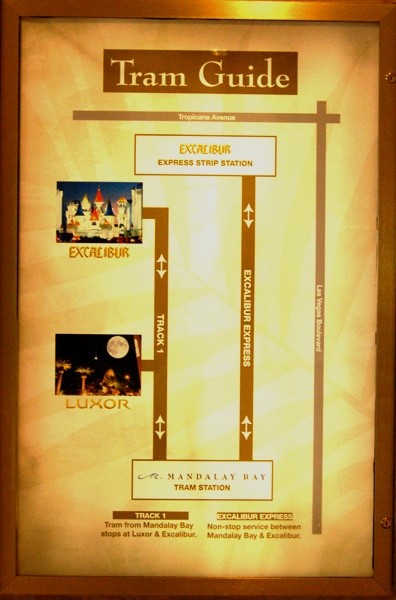I recently travelled to Las Vegas, Nevada to explore that city’s two public cable systems. This is Part 2 of a 3 Part report on the Mandalay Bay Cable Car.
The Mandalay Bay Cable Car is the kind of cable installation I love. It’s a modest, unassuming workhorse that demonstrates why cable is just so attractive a technology. It’s fast, it’s got heft and it just feels right. I know it’s impossible to quantify such a subjective concept, but – believe me – I’ve ridden several cable systems that didn’t feel right and this one does. In fact, it feels almost perfect.
The system operates 24 hours per day, 365 days of the year with a total downtime of less than 0.5%. It operates above 30 km/hr and it can move between 1,500 and 3,000 pphpd depending on your calculation. The lack of a specific capacity is due to two major factors:

The Mandaly Bay Cable Car Map. Note the Express Line and the Local Circulator Line. Image by Steven Dale.
FIRST. Because it is a hotel resort system, capacity is at least somewhat determined by people with luggage. As anyone who comes to Vegas will do so with luggage, that luggage must be accommodated for. The more luggage, the less people. This fact somewhat artificially drives down the stated capacity of the system. During times of conferences and conventions, when people from all over Vegas descend on the Mandalay Bay, the system operates well over stated capacity without trouble, a testament to the previous statement.
SECOND. The system actually operates two separate independent shuttles. One is an express connecting the Excalibur and Mandalay Bay resorts in a single swift minute, whereas the second line is a local connector with intermediary stops at the Luxor and a second Excalibur station. This is a revolutionary alignment that most higher order transit technologies don’t even accomplish.
This dual track, dual purpose configuration, however, complicates matters of capacity as well as questions of connectivity.
From the main Excalibur Terminal, there is no direct connection to the Luxor or the secondary Excalibur station. To access either of those stations, one must first take the express line to Mandalay Bay, then transfer to the local and retrace backwards to either the Luxor or Excalibur intermediary station.
It’s a truly ludicrous design to any rational transit planner. But remember: This is Las Vegas. Transportation and rationality are completely anathema to this world. The purpose of the Mandaly Bay system is not to get you to the Luxor or the secondary Excalibur station. The purpose is purely to get you to the Mandalay Bay.
It may be a piece of planning absurdity, but it’s also a piece of marketing genius, and it was intentional according to those I spoke with who work with the system. Any movement on the cable car is filtered through Mandalay Bay, ensuring maximum exposure.
It is, in essence, the Freemium Model of public transit. Mobility is offered to everyone and anyone free of charge, the price is allowing oneself to be exposed to one giant Mandalay Bay advertisement. It was no mistake, after all, that the Mandalay Bay station is located deep within the heart of the complex, whereas the other stations require a long walk through their respective casinos.
So is it transit? No. But does that question really matter? I don’t think so. The Mandalay Bay cable car was always much more about marketing than it was about mobility. It’s important to analyze a system based upon its strategic goals. Not only has the cable car been an enormous marketing success, it has also (bizarrely) succeeded as transit in ways other Vegas transit systems haven’t, namely the Las Vegas Monorail.

The Las Vegas Monorail. A perpetual money-loser, the Monorail has a spotty technical record and is increasingly underutilized. Image by Steven Dale
Whereas the not-for-profit owned Las Vegas monorail is far longer and offers better connectivity, it is so much more irrelevant than the Mandalay Bay system. One doesn’t even know the monorail exists and one really doesn’t care to. In fact, it’s totally common to find websites and forums that confuse the Mandalay Bay system for the Las Vegas Monorail. But at a $6 per trip price tag, it’s hard not to understand why the Las Vegas Monorail drives users away.
Ironically, the Las Vegas monorail as a fare-based system is a perpetual money loser that has struggled financially and technologically since it opened. The Mandalay Bay cable car, meanwhile, is free and is seen by its owners as a complete success. So much so, MGM has just recently opened a second cable system linking three other resorts (more on that system in the future).
I’ll wrap up this report tomorrow with a discussion about the Mandalay Bay cable car’s visual aesthetics and station design.
